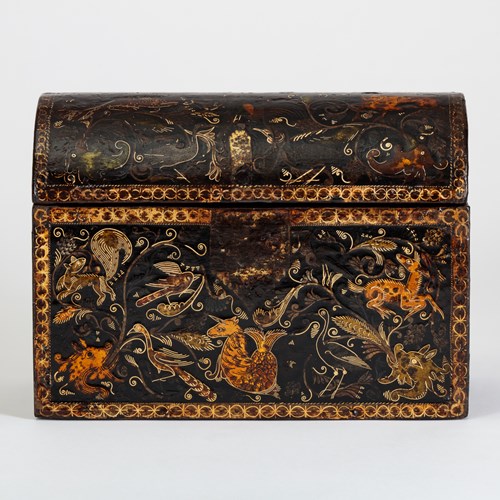A Lacquered Shield with a European Coat of Arms
Date Second half of the 17th century
Period 1600-1750, 17th century
Origin Japan, Bengal
Medium Lacquer, Leather
Dimension 57 cm (22¹/₂ inches)
This rare, large leather shield of circular and convex form, decorated in gold hiramaki-e (low relief lacquer) and takamaki-e (high relief lacquer) with a European coat of arms within a band of scrolling foliage on a black lacquer ground, the concave reverse in black lacquer. The coat of arms and the monogram are depicted within two stylised palm leaves with two branches overlapping at the bottom. The outer narrow border of the shield is decorated with delicate scrolling vines and foliage in gold. A single metal suspension ring is attached at the top.
In the second half of the 17th century, leather shields of this type were produced in Bengal and taken to Japan by the VOC (Dutch East India Company) to be lacquered and decorated with maki-e (Hutt, p. 246). Written records suggest that in 1647, 35 Bengal shields were shipped from Batavia (today’s Jakarta) to Japan to be lacquered in black and gold which were then shipped back to Batavia in 1648 (Impey, p. 252). These shields decorated in lacquer with individual family monograms and crests were made to order by members from the VOC or the Opperhoofden (the chief traders of the Dutch East India Company) in Deshima, an island in the Nagasaki harbour which was the only trading post between Japan and the outside world during the Edo period (Impey, p. 194). Shields commissioned by the VOC or the Opperhoofden became highly-prized centrepieces often used for official occasions and as showpieces; as a result such shields do not show much wear due to lack of usage by their commissioned owners (Impey, p. 45).
Another shield similarly decorated with the crowned symmetrical monogram of Johan van Leenan (the VOC functionary in Hooghly from 1658 until 1674) within a band of foliage is in the collection of the Rijksmuseum, Amsterdam, Accession Number NG-NM-541, see Impey, p. 45, fig. 40. Two Japanese lacquered wedding plates, one bearing the crowned monogram of Joan van Hoorn and Susanna Angenita van Outhoorn and another of Willem van Outhoorn and Elisabeth van Heijningen, have similar compositional features to those on the present shield (illustrated in Zandvliet, pp. 222-23, figs. 107A and 107B, p. 222).
Stock no.: A4769
Date: Second half of the 17th century
Period: 1600-1750, 17th century
Origin: Japan, Bengal
Medium: Lacquer, Leather
Dimension: 57 cm (22¹/₂ inches)
Provenance: Private European Collection
Literature: Hutt, J. ‘Asia in Europe: Lacquer for the West’ in Chapter 18, Jaffer, A. & Jackson, A. (ed.,) Encounters: The Meeting of Asia and Europe 1500-1800, V&A Publications, 2004.
Impey, O. & Jörg, C. Japanese Export Lacquer 1580-1850, Hotei Publishing, Amsterdam, 2005.
Zandvliet, K. (ed.) The Dutch Encounter with Asia 1600-1950, Rijksmuseum, Amsterdam, 2002.
More artworks from the Gallery






_T638568988938247202.jpg?width=500&height=500&mode=pad&scale=both&qlt=90&format=jpg)


_T638772029064645252.jpg?width=500&height=500&mode=pad&scale=both&qlt=90&format=jpg)